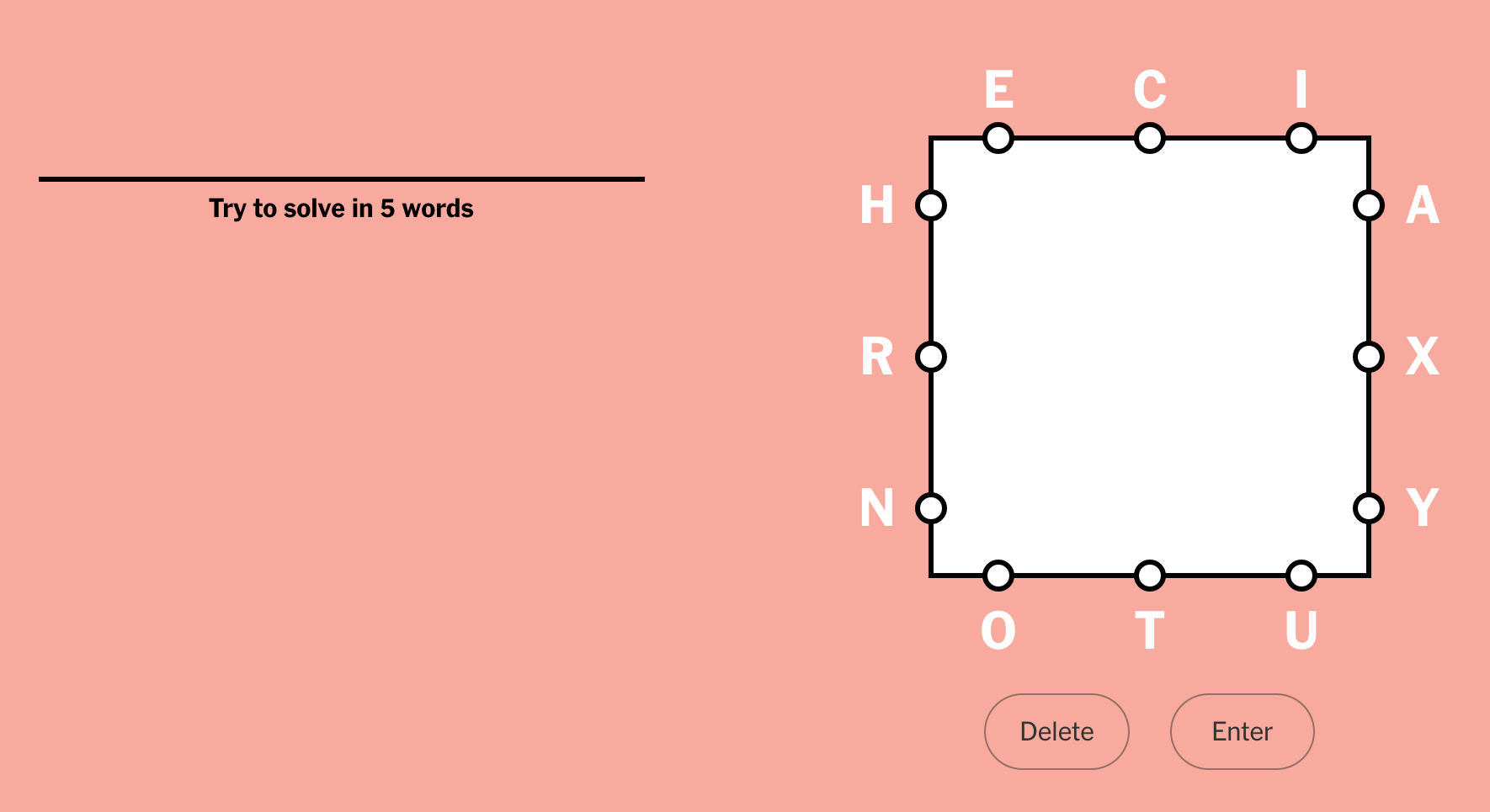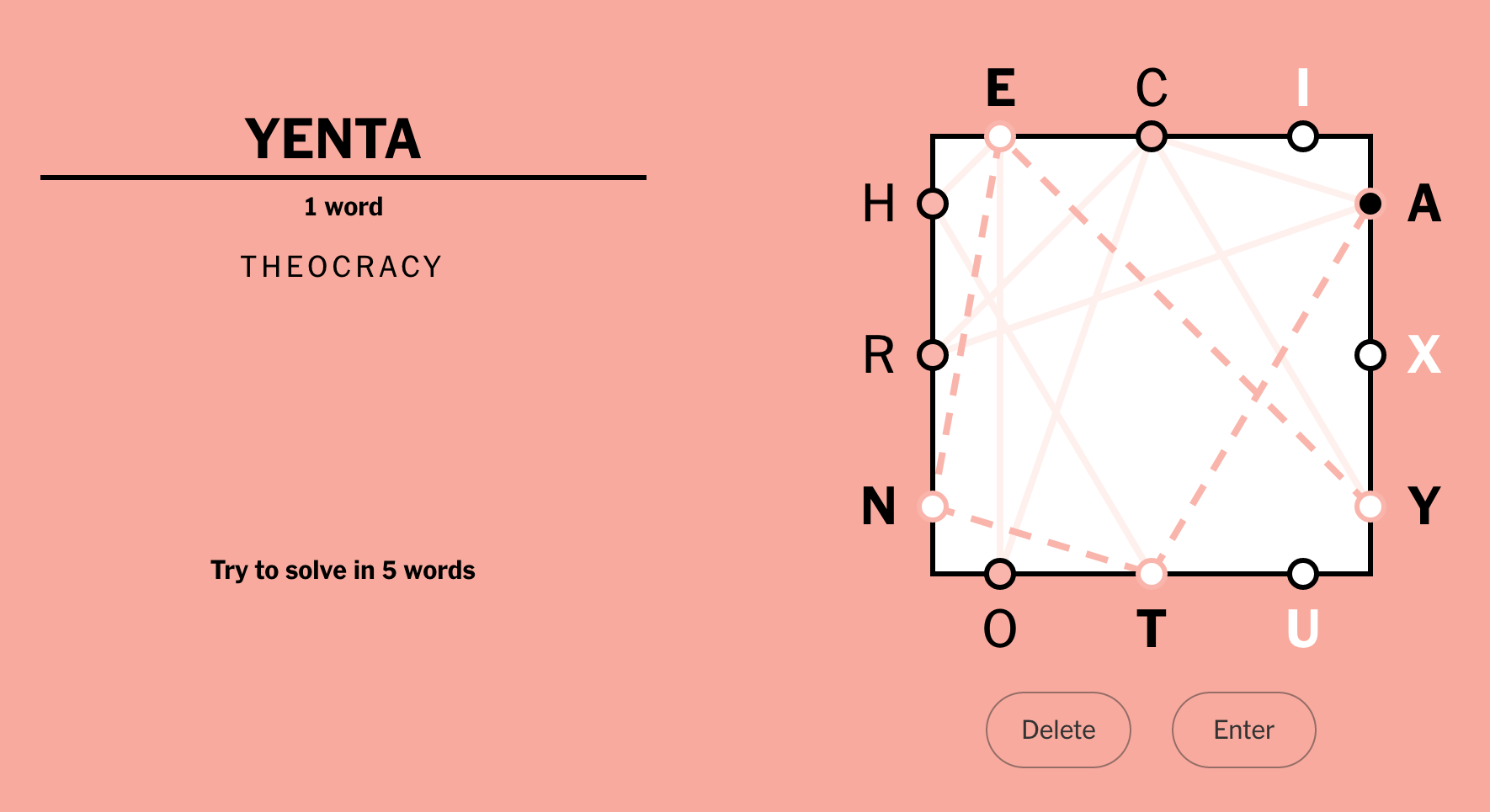With more time on my hands during this quarantine time, I started doing the Letter Boxed puzzle. You are given a square with three letters on each side:

You form words by choosing letters in sequence. The only rule is that the next letter must be on a different side of the square than the previous letter:

Your next word has to start with the last letter of the previous word:

The goal is to use all the letters in a certain number of words. For this puzzle, the challenge is five words.
But if you look at the answers they provide for yesterday’s puzzle, it’s always just two words. So now I’m tormenting myself trying to find two-word solutions. And of course I started thinking about writing a program to find them.
I found a giant list of words and started hacking on some code. I wasn’t sure if I’d need some fancy tree structure for searching the solution space. I figured I would start simpler than that, and maybe it would work.
My strategy was to whittle down the list of words a few steps at a time. First, keep only the words formed from just the 12 letters in the puzzle. Then reduce the list to only those that can be formed following the “not same side” rule. Then find pairs of words that end and start with the same letter, and use all 12 letters:
import collections
import itertools
import sys
def print_sample(label, words, n=10):
print(f"{label}: {len(words)} words: {', '.join(itertools.islice(words, n))}")
with open("words2.txt") as fwords:
words = set(w.strip() for w in fwords)
print_sample("All words", words)
sides = sys.argv[1:]
alphabet = set("".join(sides))
words = {w for w in words if set(w) < alphabet}
print_sample("Only the letters", words)
numbered_sides = {c: i for i, side in enumerate(sides) for c in side}
def is_possible(word):
for first, second in zip(word, word[1:]):
if numbered_sides[first] == numbered_sides[second]:
return False
return True
possible = {w for w in words if is_possible(w)}
print_sample("Possible words", possible)
starts = collections.defaultdict(list)
for word in possible:
starts[word[0]].append(word)
print("Solutions:")
for word1 in possible:
last = word1[-1]
for word2 in starts[last]:
if set(word1 + word2) == alphabet:
print(word1, word2)
This code is just stream-of-consciousness coding, intermixing running statements with function I needed. On some previous puzzles, it came up with way too many solutions. For “riu pgh lcs yao” it found 1002 pairs of words! Solutions like “hypacusia argol” are not satisfying...
My giant list of words has 466,551 words. I also have a smaller file with only 45,404 words. I refactored the code to make it more flexible. Now it will try the small word list first, and only go to the second larger list if there are no solutions:
import collections
import itertools
import sys
def print_sample(label, words, n=10):
print(f"{label}: {len(words)} words: {', '.join(itertools.islice(words, n))}")
class LetterBoxed:
def __init__(self, sides):
self.sides = sides
self.alphabet = set("".join(sides))
self.numbered_sides = {c: i for i, side in enumerate(self.sides) for c in side}
def is_possible(self, word):
for first, second in zip(word, word[1:]):
if self.numbered_sides[first] == self.numbered_sides[second]:
return False
return True
def solutions(self, words):
alpha_words = {w for w in words if set(w) < self.alphabet}
print_sample("Using only the letters", alpha_words)
possible = {w for w in alpha_words if self.is_possible(w)}
print_sample("Possible words", possible)
starts = collections.defaultdict(list)
for word in possible:
starts[word[0]].append(word)
for word1 in possible:
last = word1[-1]
for word2 in starts[last]:
if set(word1 + word2) == self.alphabet:
yield (word1, word2)
def main(sides):
letter_boxed = LetterBoxed(sides)
for wordfile in ["words.txt", "words2.txt"]:
with open(wordfile) as fwords:
words = set(w.strip() for w in fwords)
print_sample("All words", words)
solutions = list(letter_boxed.solutions(words))
if not solutions:
print("No solutions with these words")
continue
print(f"{len(solutions)} solutions:")
for word1, word2 in solutions:
print(word1, word2)
break
if __name__ == "__main__":
main(sys.argv[1:])
With this, “riu pgh lcs yao” finds five solutions from the short word list, using words I actually know, like “gracious splashy.”
Unfortunately, sometimes the official solution uses words that aren’t in even the enormous word list. A previous puzzle was “tub pxi snq oja”, and the solution offered was “juxtaposition niqab,” which is frustrating. Playing word puzzles inevitably brings you face to face with the differences between accepted word lists.
After I wrote my code, I found:
- Caleb Robinson’s blog post about his solution, which involved the fancier tree structures I avoided.
- Art Steinmetz’s blog post about both generating the puzzle and solving it, in R. He mentions the generalizations of different numbers of sides, and numbers of letters per side. I was amused to realize that my code doesn’t care how many sides or letters per side are used, so it works for any number.
Just for grins, I’m wondering if there’s some crazy way to abuse regexes to do most of the work. Too much time on my hands...
Comments
For puzzle→pattern, the tree of possibilities generalizes to 12! = 479001600 (it's less because of grouping into edges, but the full factorial is certainly an upper bound). That number is far too large for a single regex of nested (?:a|b) style alternatives.
Making a pattern from the word list would face similar challenges. At least you would only have to do it once, not for each puzzle!
I think what this means, ultimately, is that you can't really make a single regex that will search either space to find a solution in one pass. That makes this exercise somewhat less satisfying...
You can still use regexes to filter the words and possible solutions before running a non-regex checker to speed things up.
For example, using the 12-letter alphabet from your example puzzle:
^[acehinortuxy]{1,12}$Applying that to my input word list reduces the count from 370104 to 8765.You can also filter the words that have the right numbers of letters. Here is a check that ensures a word has at most one letter "a"
^(?:[^a]*+a){0,1}[^a]*+$(That uses possessive quantifiers to avoid catastrophic backtracking, but they aren't available in the built-in Python re... You can get possessive quantifiers in the external Python regex module in PyPI.)If that regex seems a little overcooked, for example {0,1} is the same as ?, it's because you'd want to build the regex programmatically from the puzzle input, and it should work even if there are two or three a's available. Here is a longer version that considers all the available letters. This uses forward-lookaheads because the letters can be in any order:
(?x) ^ (?= (?:[^a]*+a){0,1} [^a]*+ $) (?= (?:[^c]*+c){0,1} [^c]*+ $) (?= (?:[^e]*+e){0,1} [^e]*+ $) (?= (?:[^h]*+h){0,1} [^h]*+ $) (?= (?:[^i]*+i){0,1} [^i]*+ $) (?= (?:[^n]*+n){0,1} [^n]*+ $) (?= (?:[^o]*+o){0,1} [^o]*+ $) (?= (?:[^r]*+r){0,1} [^r]*+ $) (?= (?:[^t]*+t){0,1} [^t]*+ $) (?= (?:[^u]*+u){0,1} [^u]*+ $) (?= (?:[^x]*+x){0,1} [^x]*+ $)Applying that reduces the potential words contributing to a solution from 8765 to 2193.One more filter you can apply is making sure that candidate words follow the edge-to-edge rules, meaning that you don't use two letters in a row from one edge of the puzzle. For example, considering the ECI edge of your sample puzzle, it must be followed by one of the letters from the other edges:To make this check an entire word, we need to consider all the source and destination edges, plus use forward lookaheads to avoid consuming more than one character at a time:
(?x) ^ (?: (?= [cei](?:$|[ahnortuxy]) | [axy](?:$|[cehinortu]) | [otu](?:$|[acehinrxy]) | [hnr](?:$|[aceiotuxy]) ) . # consume the char )* $Applying that pattern reduces the potential words from 2193 to 1213. It doesn't check whether letters have already been used, but when you combine it with the other checks, the list is narrowed considerably before you need to resort to a non-regex algorithm for the final step.@Julian: you are right, my code won't handle duplicated letters. The puzzle online seem to never have them, so I'm OK with the limitation.
The tl;dr though: I don't see a way to solve with regexes, but you can use them to reduce the solution space before running a non-regex algorithm.
inputs are a list of sides and the path to a word list (like '/usr/share/dict/words').
def legal_words(sides, word_list): # "Illegal" regexes. If any match then the word is not usable. # `tooshort` is less than 3 characters. # `badletters` is any letter not on the puzzle board. # `badsequence` means a repeated letter on the same side of the board. # Eliminating `badletters` before `badsequence` keeps the sequence regex sane. tooshort = r'^.{1,2}$' badletters = '[^' + ''.join(set(''.join(sides))) + ']' badsequences = '|'.join(['[' + side + '](?=[' + side + '])' for side in sides]) regex = re.compile('|'.join([tooshort, badletters, badsequences]), re.IGNORECASE) return [word for word in Path(word_list).read_text().split() if not regex.search(word)]so, for instance today's letter list is:which creates the regex:re.compile(r'^.{1,2}$|[^temapubrfilo]|[utp](?=[utp])|[aef](?=[aef])|[mli](?=[mli])|[bor](?=[bor])', re.IGNORECASE|re.UNICODE)How are words entered separately on the letter boxed game and how is the final answer submitted?
I solved in 1 word a couple of days ago.
Does anyone know if there is a hidden 1-word solve every day?
I very rarely get it in two. But today (12/6) I did but wanted to post my solution but couldn’t locate how. In any case, here it is: motivator / recuperatory.
Add a comment: